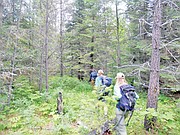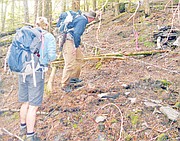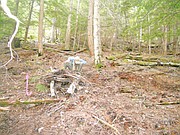Study seeks area bear vital statistics
The mosquitoes are swarming over Kasey Mulcahy and Katherine Spendel as they look at the decade old GPS and try to get their bearings.
“I think the mountain is this way,” Spendel said, pointing northwest.
“No, see the tree line starts getting higher over here,” Mulcahy insisted, pointing south.
The two are techs on the Cabinet-Yaak DNA Project, and even they get lost once in a while, although they insist it only happens when they have guests.
The Cabinet-Yaak DNA Project is a season-long research effort to determine the number, density and population trends of grizzly bears in the ecosystem, something that wildlife interest groups and businesses need to know for bear litigation.
If the bears are thriving in the Cabinet-Yaak, it will be on its way to recovery, as the ecosystem has long been struggling to maintain population levels. If the numbers have slipped, it is possible that mining and timber companies will have a stronger case to expand operation, something impossible now because large activities may scare bears away from historic habitats.
Project Manager Kristina Boyd cautions that painting the situation as one of man vs. bear is reductive and doesn’t help anyone.
“There may be people who hate grizzlies, but the timber companies don’t want to hurt them,” she said. “But everyone’s got to make money. It’s starting a dialogue in this community that hasn’t happened before.”
Kate Kendall, research ecologist with the U.S. Geological Survey and overseer of the project, echoes Boyd’s sentiments.
“From conservation to industry to the state, federal and tribal support, everyone would like solid information,” Kendall said. “Everyone I’ve talked to about the project has been interested and think it’s cool.”
The project’s goal is to get a sample of every bear it can in the area by grabbing hair from designated hair-traps to get accurate numbers of the population.
Spendel and Mulcahy quickly find the flagging they are looking for and before long have arrived at the “hair corral,” an enclosure of 100 feet of barbed wire, wrapped around trees at knee level with lure in the middle.
The lure is a putrid mixture of cow blood, puréed fish and anise that is poured on a pile of branches inside the corral. The rotten meat smell (along with the black licorice-like anise added on top to change the smell slightly) is enticing to grizzly bears, which will make predatory kills if necessary, but mostly are scavengers by nature.
The bear will have to cross the barbed wire to see what the smell is. It might scatter the branches about to see whether there is any food, and finding none, will depart around two minutes after arrival.
The bear, if everything goes according to plan, will leave behinds tufts of fur on the barbed wire, which is then collected and shipped off to Wildlife Genetics International, in Nelson, British Columbia.
“The lab has less than a 1 percent chance of misidentifying a genome,” Boyd said. “They scored 100 percent accuracy on a blind sample test we gave them.”
Fish, Wildlife & Parks has spent time working on the project as well, doing hair samples of its own, but working largely with radio telemetry (collar) work to study not the numbers, but the population trends.
Wayne Kasworm, a U.S. Fish & Wildlife bear biologist, has spent years dealing with the grizlies in the area, wanted to make clear how the 45 minimum estimated bears in the area were tabulated.
“These are based on captures and hair snagging and the information is on individual bears in the last 6-10 years,” Kasworm said. “Are all of those bears still alive today? We don’t know.”
While the estimated 45 bears is a larger number than in recent past, the area won’t be considered recovered until it reaches levels of 100 bears. No timeline had been set for this level, but those close to the project were guardedly optimistic.
The Cabinet-Yaak ecosystem has grizzlies listed as threatened and is warranted for endangered levels, Kasworm said. One of the biggest reasons for this is the mortality outstripping reproduction and of those mortalities, illegal human-caused death is the highest.
Of the five bear deaths last year, Kasworm said that one was natural, three were human-caused and one is yet to be determined. Boyd said that even one untimely death can take a large toll on a bear population.
“Female bears can only start bearing cubs at 7-years-old,” Boyd said. “And with cub survivability rate ranging from 50-70 percent, the loss of a female can be a huge hit. The recovery zone is long and narrow.”
Compounding the troubles for grizzlies locally, the Yaak drainage bears and the Cabinet Mountain bears have little to no genetic interchange. The river, train tracks and Highway 2 divide the Kootenai Valley, making crossing difficult from the Yaak to the Cabinet ecosystem, and vice-versa.
According to Kasworm, it isn’t impossible for bears to cross, just rare.
“Recently, some augmentation bears have crossed over. A female crossed from the Cabinet to the Yaak and all the way home to Glacier National Park,” Kasworm said. “But that is not the case with native bears. It is just not a place that bears would choose to cross regularly.”
While those bears in the Yaak can move north and exchange genetic material with Canadian bears, those in the Cabinet are isolated, shrinking the gene pool and bringing with it all the problems of inbreeding.
These problems have the clock ticking on the ecosystem here, so the work the DNA project is doing, even pouring the cocktail of blood and fish on a pile of sticks in the woods, is all to help preserve and conserve northwest Montana’s grizzly bears.
The last hitch will be in late August, and every hair corral and bear rub will be taken down by August 29, good news for hunting season.












